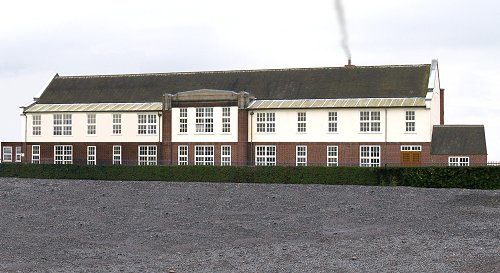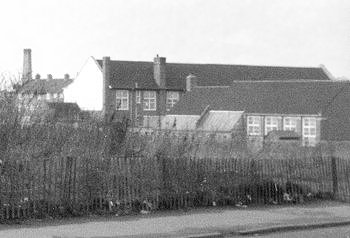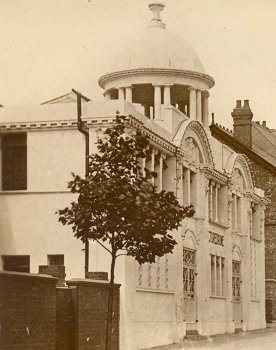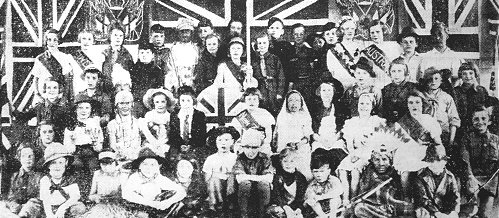| The mid 1930s were a time of optimism and looking to
the future, because the area was recovering from the
effects of the severe depression at the beginning of the
decade. Local industries were getting back on their feet
and the numbers of unemployed in the area were falling.
A bright future seemed certain and the local council
took the decision to build a new primary school.
Dorsett Road School appears to have been out of
favour by the late1930s because its pupils were
slowly transferred to other schools. As part of this
scheme a new school with the latest facilities was
required and so the council acquired part of the site of
the old Russian Colliery, which had closed by 1881. The
remaining part of the site had been purchased by Pat
Collins who ran local funfairs. |
|

Pat Collins' fair on the "Wake
Field" in the mid 1960s. |
Around this time he purchased a lot of derelict land
in the Black Country, levelled it where required, and
applied a covering of gravel to make a suitable surface
for a fairground. This particular piece of land had good
access and so was ideal for his purpose. It became known
as the “Wake Field” and was the third of Pat’s sites in
Darlaston. He previously had a site at The Green, and
one where the old tram sheds stood. |
| Before work could begin on the new school there
would have been part of a large pit mound to clear,
shafts and underground workings to fill, and a lot of
consolidation work to be done. Pinfold Street School
opened its doors for the first time on 1st September,
1936 providing accommodation for 350 junior and infant
children. At the beginning only six classrooms were in
use, and
in the early years the school
playground was divided into two halves by steel
railings, the rear half for the junior boys, and the
front part for the infants and junior girls.
The teaching staff were as follows:
| Hilda
Dangerfield – temporary head
teacher |
| Miss Eleanor
Foster |
| Mr. Frederick
Hudson |
| Miss Isabel
Thornton |
| Miss Enid
Fairhall |
| Mrs. Dorothy
Bailey |
|

An impression of how the school might have
looked in the early years.
|
On the first day 208 children were admitted, 175 of
whom, came from Dorsett Road School. They were welcomed
in the hall by Councillor F.W. Wesson
on behalf of the school management team, and Dr. A.B.
Lavelle, the Rector of Darlaston.
The staff were joined in December by Miss Joan
Nicholls, who had initially been given a temporary
appointment to carry out Miss Fairhall’s duties while
she went on a number of visits to other schools in
England. On her return, Miss Fairhall joined a party of
teachers on an educational tour of Italy, which ended
her service at Pinfold Street. As a result Joan Nicholls
remained at the school for many years. The school closed
for Christmas on December 23rd with its first
Christmas party.
A further 19 children were admitted when the school
reopened on January 11th. During the early
part of the year many children were absent with coughs
and colds and a severe snowstorm in March resulted in a
very poor attendance of only 150.
|
| The school held its first Coronation celebrations on
11th May for King George 6th when
Darlaston councillors W.W.
Stanbury, E. Ward, F. Biddlestone, and G. Smith
distributed souvenir medals to the children. The
celebrations continued on May 24th when the
children attended a Coronation service at the football
ground, followed by tea at the school. The school’s
first sports day took place on the afternoon of July 1st,
and the first year ended on July 29th with
the start of the summer holiday. |

A view of the school from Moxley
Road in 1963. |
| At the beginning of the new year on September 1st,
a further 38 children were admitted, and Mrs. Elizabeth
Buck joined the teaching staff. In January the seventh
classroom was ready for use and the number of children
had risen to 299, rising again after Easter to 321.
Numbers increased again in September, 1938 when the
final group of children were transferred from Dorsett
Road School and an extra classroom opened in the junior
department. Two new members of staff started on
September 1st. The first, Miss Alice
Parkinson had been transferred from Dorsett Road School,
and the second, Miss Josephine Haigh, had come from
Neachells Lane Junior School in Wednesfield, and would
stay for many years to become a legend in her own time.
The new intake included 18 five year olds and 38
children from Dorsett Road School, bringing the total
number to 376. This necessitated the use of the
emergency room as a temporary classroom. At the end of
the month, Hilda Dangerfield, the temporary head teacher
was appointed as head teacher at Elm Street School in
Willenhall, and in November Mr. John Thacker joined the
staff as their new headmaster. He had previously worked
at West Street Methodist Junior School, in Leek and
would soon become a well-respected figure at the school.
|
|

The Picturedrome Cinema. |
The children were actively encouraged to save their
money, and in October the juniors went to the
Picturedrome cinema in Crescent Road to see films about
National Savings. The National Savings Movement relied
upon volunteers who were organised into Local Savings
Committees and supported by national committees and
civil servants. Saving stamps, certificates, and bonds
were sold to the public and were available at post
offices, savings banks, and building societies. Local
volunteers were recognized for their dedication by the
issuing of long service awards, and savings groups were
formed in factories, shops, clubs and schools. The
savings were collected by an appointed collector who not
only collected the savings but also issued certificates.
In the 1940s local savings weeks became regular events
and posters were produced for advertising. Mr. Thacker
would organise the school’s contribution to the scheme. |
|
Miss Haigh travelled daily from Wolverhampton,
sometimes with temporary teacher, Joan Nicholls. On
November 14th they were passengers on a bus
which was involved in a serious collision. Luckily they
were both unhurt. The school suffered its first damage
on November 23rd, during a severe storm,
which removed lead from the veranda.
By the beginning of 1939 the total number of children
had risen to 386, with an average attendance of 329. All
of the children were periodically examined by a visiting
school nurse and dentist. They attended school clinics
where their hair was examined to see if it was free from
dirt and nits (head lice), which would be a recurring
problem. They also received polio injections and dental
treatment.
On May 24th the school celebrated Empire
Day, which for many years became an annual event. The
children would dress-up in costumes representing various
countries and carry appropriate flags. They would learn
suitable songs and present an Empire pageant to parents
and friends.

| The
school's Empire Day celebration
in 1939. Courtesy of Sue Harper,
Gill Broomhall and Maureen Page. |
|
The school closed for its summer break on August 3rd.
In the afternoon a large number of parents came along to
inspect the children’s work and watch dramatic
performances on the school stage. The
decade had been dominated by the growing threat of
fascism in Europe, and war with Germany would soon be
declared. When the children returned to the school after
their summer holiday, things would be very different. |
 |
|
 |
|
 |
Return to
Background |
|
Return to the
beginning |
|
Proceed to
The War Years |
|